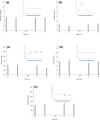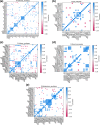Sportomics suggests that albuminuria is a sensitive biomarker of hydration in cross combat
- PMID: 35581242
- PMCID: PMC9114005
- DOI: 10.1038/s41598-022-12079-7
Sportomics suggests that albuminuria is a sensitive biomarker of hydration in cross combat
Abstract
We have been using sportomics to understand hypermetabolic stress. Cross Combat (CCombat) has recently been initiated as a high-intensity functional training method inspired by CrossFit. We used a CCombat session to induce metabolic stress and evaluated its effects on hydration and kidney function. Blood samples were collected from 16 elite-level professional male athletes engaged in training sessions over a 96-h protocol. Blood myoglobin increased by ~ 3.5-fold (119 ± 21 to 369 ± 62 nmol/L; p = .001) in response to the protocol, returning to the pre-exercise level within 48 h. Furthermore, D-dimer levels increased from 6.5 ± 0.6 to 79.4 ± 21.3 μmol/L (p < .001) in response to exercise decreasing during recovery with high variability among the studied athletes. Albuminemia and creatininemia increased ~ 10% and cystatin C increased ~ 240% (1.7 ± 0.1 to 5.7 ± 0.5 mg/L; p < .001; effect size = 2.4) in response to the protocol. We measured albuminuria (HuA) to assess kidney permeability to albumin caused by exercise. HuA increased ~ 16-fold (0.16 ± 0.03 to 2.47 ± 0.41 μmol/L; p < .001; effect size = 1.4) in response to exercise, dropping and reaching basal levels during 48 h. Here, we suggest that microalbuminuria can be used as an early, sensitive, easy, and inexpensive biomarker to evaluate hydration status changes during intensive exercise, decreasing chronic impairment in renal function.
© 2022. The Author(s).
Conflict of interest statement
The authors declare no competing interests.
Figures








References
-
- Bongiovanni T, et al. Sportomics: Metabolomics applied to sports. The new revolution? Eur. Rev. Med. Pharmacol. Sci. 2019;23:11011–11019. - PubMed
MeSH terms
Substances
LinkOut - more resources
Full Text Sources

